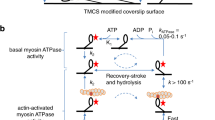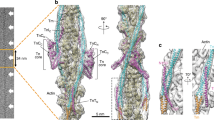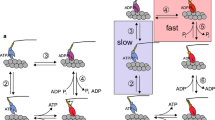Abstract
Fluorescence of skinned psoas fibres reconstituted with the troponin C subunit labelled with the fluorescent probe dansylaziridine (TnCDANZ) increases upon activation with Ca2+. This fluorescence enhancement is due to Ca2+ binding to the Ca2+-specific binding sites of TnCDANZ and attachment of cross-bridges to the actin filament. We found that approximately 20% of the enhanced fluorescence signal derived from Ca2+ binding to TnCDANZ and 80% from cross-bridge attachment during maximal activation. Furthermore we studied the effects of different cross-bridge states on TnCDANZ fluorescence. “Weakly” bound, non-force-generating cross-bridge states (pCa 8, low ionic strength) and rigor cross-bridges revealed similar effects on the TnCDANZ fluorescence. “Strongly” attached, force-generating states, however, increased fluorescence to the greatest extent. These results suggests a complex system of reciprocal couplings between TnC and different attached cross-bridge states. Cooling or increase of inorganic phosphate decreased isometric force but hardly decreased fluorescence, suggesting the accumulation of attached cross-bridge states with low tension output.
Similar content being viewed by others
References
Allen TStC, Gordon AM (1982a) Cycling cross-bridges produce structural changes in troponin C in demembranated fibers of rabbit psoas muscle. J Physiol (Lond) 418:63P
Bremel RO, Weber A (1972) Cooperation within actin filament in vertebrate skeletal muscle. Nature 238:97–101
Brenner B (1986) The cross-bridge cycle in muscle. Mechanical, bichemical, and structural studies on single skinned rabbit psoas fibers to characterize cross-bridge kinetics in muscle for correlation with the actomyosin-ATPase in solution. Basic Res Cardiol 81:1–15
Brenner B (1988) Effect of Ca2+ on cross-bridge turnover kinetics in skinned single rabbit psoas fibers: implications for regulation of muscle contraction. Proc Natl Acad Sci USA 85:3265–3268
Brenner B, Schoenberg M, Chalovich JM, Greene LE, Eisenberg E (1982) Evidence for cross-bridge attachment in relaxed muscle at low ionic strength. Proc Natl Acad Sci USA 79:7288–7299
Brenner B, Yu LC, Podolsky RJ (1984) X-ray diffraction evidence for cross-bridge formation in relaxed muscle fibers at various ionic strength. Biophys J 46:299–306
Ebashi S, Kodoma A, Ebashi F (1968) Troponin I: preparation and physiological function. J Biochem (Tokyo) 64:465–477
Fabiato A, Fabiato F (1979) Calculator programs for computing the conpositions of the solutions containing metals and ligands used for experiments in skinned muscle cells. J Physiol (Paris) 75:463–505
Grabarek Z, Grabarek J, Leavis PC, Gergely J (1983) Cooperative binding to the Ca2+-specific sites of troponin C in regulated action and actomyosin. J Biol Chem 258:14098–12102
Güth K, Potter JD (1987) Effect of rigor and cycling cross-bridges on the structure of troponin C and on the Ca2+ affinity of the Ca2+-specific regulatory sites in skinned rabbit psoas fibers. J Biol Chem 262:13627–13635
Güth K, Wojciechowski R (1986) Perfusion cuvette for the simultaneous measurement of mechanical, oprical, and energetic parameters of skinned muscle fibers. Pflügers Arch 407:552–557
Hibbero MG, Dantzig JA, Trentham DR, Goldman YE (1985) Phosphate release and force generation in skeletal muscle fibers. Science 228:1317–1319
Huxley HE (1972) Structural changes in the actin and myosin containing filaments during contraction. Cold Spring Harbor Symp Quant Biol 37:361–376
Johnson JD, Collins JH, Potter JD (1978) Dansylazirdine-labelled troponin C. A fluorescent probe for Ca2+ binding to the Ca2+-specific regulatory sites. J Biol Chem 253:6451–6458
Johnson JD, Collins JH, Robertson SP, Potter JDJ (1980) A fluorescent probe study of Ca2+ binding to the Ca2+-specific sites of cardiac troponin and troponin C, Biol Chem Hoppe Seyler 255:9635–9640
Kentish JC, Palmer S (1989) Calcium binding to isolated bovine cardiac and rabbit skeletal troponin-C is affected by pH but not by caffeine or inorganic phosphate. J Physiol (Lond) 417:160P
Kuhn HJ, Güth K, Drexler B, Berberich W, Rüegg JC (1979) Investigation of the temperature dependence of the cross-bridge parameters for attachment, force generation, and detachment as deduced from mechano-chemical studies in glycerinated single fibers from the dorsal longitudinal muscle of lethocerus maximus. Biophys Struct Mech 6:1–29
Persechini A, Stull JT, Cooke RJ (1985) The effect of myosin phosphorylation on the contractile properties of skinned skeletal muscle fibers. Biol Chem Hoppe Seyler 260:7951–7954
Potter JD, Gergely J (1975) The calcium and magnesium binding sites of troponin and their role in the regulation of myofibrillar adenosinetriphosphatase. J Biol Chem 250:4628–4633
Zot HG, Potter JD (1987) Calcium binding and fluorescence measurements of dansylazirdine-labelled troponin C in reconstituted thin filaments. J Muscle Res Cell Motil 8:428–436
Zot AS, Potter JD (1989) Reciprocal coupling between troponin C and myosin cross-bridge attachment. Biochemistry 28:65751–6756
Author information
Authors and Affiliations
Rights and permissions
About this article
Cite this article
Morano, I., Rüegg, J.C. What does TnCDANZ fluorescence reveal about the thin filament state?. Pflugers Arch. 418, 333–337 (1991). https://doi.org/10.1007/BF00550870
Received:
Revised:
Accepted:
Issue Date:
DOI: https://doi.org/10.1007/BF00550870




